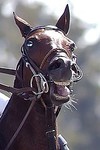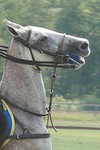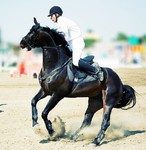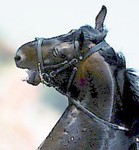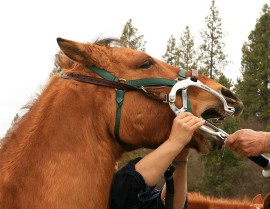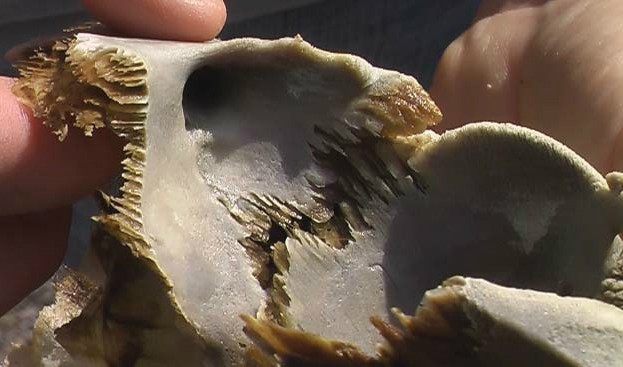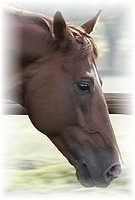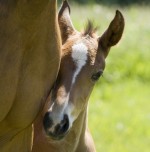Equine CranioSacral Therapy (ECS)
A powerful, though gentle, mainly hands on, healing practice,
which can be highly effective in the treatment of many injuries and conditions in horses and ponies;
including behavioural and psychological problems.
ECS is unique - as it focuses on (but is not limited to) the Equine Cranium, Spinal Cord, and Sacrum;
their relationship to each other - and their effects on the rest of the body.
Most horses can benefit from ECS; especially as all will experience regular pressures and stresses
throughout their lives - These can be from 'every day' items such as tight fitting nosebands, pressures from bits,
incorrectly fitting tack, as well as field accidents, injuries, and the like.
If there were any one single reason to use ECS - It would have to be after Dental work
Dentistry is a very important and necessary component of equine health, and should be regularly carried out by a qualified professional.
The Speculum (as shown) together with hand tools and sometimes power tools, are all required for dental procedures to be carried out as efficiently and safely as possible. However, the horse's reactions to having the mouth held open in such an unnatural position (especially when under sedation), and also the actual work itself can lead to unhealthy pressures being put onto the bones of the skull and muscles of the TMJ; with enevitable consequences - such as compensatory patterns in mastication (chewing) leading on to many other issues,
and even sometimes the need for more Dentistry.
CranioSacral work should always be performed after Dentistry to restore balance to the Muscles and Bones of the Skull ...
with Maureen Rogers of Equine CranioSacral Workshops;
(Approx 6 minutes total)
Interviewed by Natural Horse Talk.com
Takes a few seconds to load.
ECS+and+Equine+Dentistry.mp3 (audio mpeg[...]
MP3 audio file [1.1 MB]
Just some examples of where ECS can also be used with success are in the treatment of:
HEAD SHAKING - CRIBBING - BACK AND JOINT PROBLEMS - BUCKING - COLIC - LAMENESS HEAD INJURIES AND TRAUMAS - HEADACHES - FEELING FLAT IN WORK - POSTOPERATIVE RECOVERY
HEAD SHYNESS AND SPOOKINESS - STUMBLING and TRIPPING
TMD and IMBALANCES OF THE TMJ - RESPIRATORY PROBLEMS
FOLLOWING A PULLBACK - DIFFICULTY WITH TRANSITIONS
The equine Skull is made up of 26 individual plates of bone -
These are joined together by Sutures, which act like joints between the Cranial bones, and are designed to help disperse the energy from an impact to the Skull. All bone is healthy living tissue, and has both a blood supply and a fatty tissue, giving it a degree of natural pliability.
The bones may become jammed as a result of head trauma which can lead to neuorological conditions.
CranioSacral work focuses on restoring balance throughout this structure
and the rest of the body.
The photograph below of part of the skull of a young horse shows that the plates are not fused together and are natuarally
pliable.
Could your horse be carrying a burden?
That does not mean the rider!
Horses and Ponies are similar to humans; they can store for years, buried deep within,
the effects of past traumas, injuries, and bad memories; which should have been processed and either released, or integrated at the time, but were instead 'shelved' whilst the initial recovery took place.
After time these can become, and remain locked in; thereby preventing the horse from becoming free again and moving on.
Just another of the many benefits of Equine CranioSacral work is that it can reconnect the horse with it's own natural process of allowing the gentle unwinding and release of what needs to go. Relief !
A newborn foal has a Skull which is made up of even more individual plates, and continues developing to the age of 5 - 6 years.
Any significant external pressures, like pull backs or compression from trauma, on a young horse's Skull will result in deep, long term and long lasting effects -
If left untreated, this can result in behavioural issues, spookiness,
TMJ issues, collection problems and other difficulties in work - to name just a few.
What to expect from an ECS session:
Practitioners will first assess a horse's movements, posture, and soft tissue; then will place highly sensitive hand and finger pressure to specific points, which may be anywhere on the horse's body, to suit the individual needs of each horse at that particular moment and time.
Whilst specific attention is given to the Cranium, and Sacrum; treatment is not limited to these areas
due to how the body is connected:
Like to know more ???
The energies applied, and also activated within the horse itself, work to heal, release stresses, and stored trauma; also to release restrictions in the Musculoskeletal system, and in the Facia, a tissue that weaves the whole body together like a spiders web.
There is no physical manipulation to the bones and tissue.
Positive physical reactions are frequently exhibited in a variety of forms by a horse,
and sometimes by their owners also!
This can happen both during and after a session.
with this easy listening, and information packed 27 minute interview by Natural Horse Talk.com with Maureen Rogers
of Equine CranioSacral Workshops
Takes a few seconds to load
Equine CranioSacral.mp3
MP3 audio file [4.7 MB]


